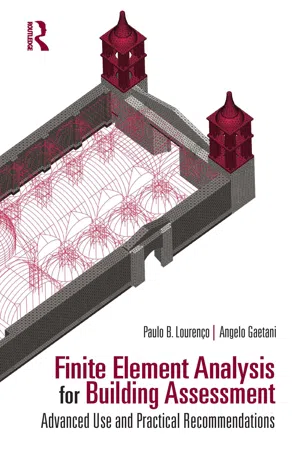
Finite Element Analysis for Building Assessment
Advanced Use and Practical Recommendations
- 400 pages
- English
- ePUB (mobile friendly)
- Available on iOS & Android
Finite Element Analysis for Building Assessment
Advanced Use and Practical Recommendations
About this book
Existing structures represent a heterogeneous category in the global built environment as often characterized by the presence of archaic materials, damage and disconnections, uncommon construction techniques and subsequent interventions throughout the building history. In this scenario, the common linear elastic analysis approach adopted for new buildings is incapable of an accurate estimation of structural capacity, leading to overconservative results, invasive structural strengthening, added intervention costs, excessive interference to building users and possible losses in terms of aesthetics or heritage values. For a rational and sustainable use of the resources, this book deals with advanced numerical simulations, adopting a practical approach to introduce the fundamentals of Finite Element Method, nonlinear solution procedures and constitutive material models. Recommended material properties for masonry, timber, reinforced concrete, iron and steel are discussed according to experimental evidence, building standards and codes of practice. The examples examined throughout the book and in the conclusive chapter support the analyst's decision-making process toward a safe and efficient use of finite element analysis.
Written primarily for practicing engineers, the book is of value to students in engineering and technical architecture with solid knowledge in the field of continuum mechanics and structural design.
Frequently asked questions
- Essential is ideal for learners and professionals who enjoy exploring a wide range of subjects. Access the Essential Library with 800,000+ trusted titles and best-sellers across business, personal growth, and the humanities. Includes unlimited reading time and Standard Read Aloud voice.
- Complete: Perfect for advanced learners and researchers needing full, unrestricted access. Unlock 1.4M+ books across hundreds of subjects, including academic and specialized titles. The Complete Plan also includes advanced features like Premium Read Aloud and Research Assistant.
Please note we cannot support devices running on iOS 13 and Android 7 or earlier. Learn more about using the app.
Information
Chapter 1 Fundamentals of the finite element method
Introduction
1.1 Equilibrium of a three-dimensional body in elasticity
For a given system of body forces b and surface tractions t, imposed displacements uS, initial strains ε0 (with no evident relation with stress, e.g. temperature change or shrinkage) and initial (residual) stresses σ0 applied to a constrained structure of a certain geometry and materials, calculate the compatible displacement field u and strain state ε, as well as the equilibrated stress state σ and constraint reactions r.
Table of contents
- Cover
- Half Title Page
- Title Page
- Copyright Page
- Table of Contents
- Foreword
- Preface
- Authors
- 1 Fundamentals of the finite element method
- 2 Nonlinear structural analysis
- 3 Constitutive models
- 4 Recommended properties for advanced numerical analysis
- 5 Guidelines for practical use of nonlinear finite element analysis
- Index